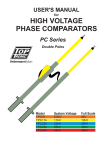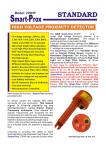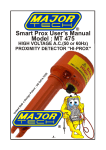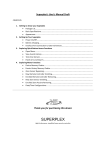Download Read more... - First Choice Global
Transcript
PERSONAL ELECTROCUTION GUARD AC VOLTAGE (50 or 60Hz) INSTRUCTION MANUAL TABLE OF CONTENTS SAFETY RULES ..................................................... 01 GENERAL DESCRIPTION ..................................... 02 PRINCIPLE OF HOW IT WORKS .......................... 02 CHECK IT AND GET IT GOING ............................. 03-04 Check the working of the PEG ........................... 03 Low battery detection and indication .................. 03 Sensitivity ........................................................... 03 Priority of functions - display and sound alerts .. 04 LOW VOLTAGE TESTING ..................................... 05 FOR BEST RESULTS ............................................ 05 FRONT PANEL LAYOUT ........................................ 06 BACK OF PEG LAYOUT ........................................ 07 PREPARATION FOR USE ..................................... 08 CHECKING AND PROOFING THE TESTER ........ 08 TYPICAL USES ..................................................... 09 BROKEN WIRES IN CABLES ............................... 09 NON CONTACT ADVISE ...................................... 09 LIMITATIONS OF THE PEG .................................. 10 LABORATORY AND FIELD TEST RESULTS ....... 11 SPECIFICATIONS ................................................. 12 LIMITED WARRANTY ........................................... 13-14 SAFETY RULES The Personal Electrocution Guard (PEG) has been designed with safety in mind. However, no design can completely protect against incorrect use. Electrical circuits are dangerous and lethal through lack of caution or poor safety practice. Please follow safety rules to reduce danger and practice safety. You are advised to take note of the following important points; • Read the User's manual carefully and completely before using the tester. Fully understand the instructions before using this product. Follow the instructions for every test. Take all the necessary precautions. Do not exceed the limits of this instrument. • The PEG should never be in physical contact with any conductor higher than 1kV. This is proximity detector. It is not a detector which works by contact. As such, contact should be avoided. • Always check that the PEG is working correctly before and after the test (press both push button to verify the device is working perfectly before using the testers to detect voltage and repeat same after detection). • Do not touch any exposed wiring, connections or other "Live" parts of an electrical circuit. • This instrument should only be used by a competent, suitably trained person which understands fully this test procedure. Personal working with High Voltage should be trained regularly. Use Protective gear. Caution, risk of electric shock. Caution, refer to the user's manual. -1- GENERAL DESCRIPTION The PEG consists of an internal pickup AC sensor plate, a test (oscillator) and diagnostic circuit, an adjustable threshold comparator, a sound annunciator (buzzer), a visual indicator (super high bright led) and a 9V battery, all enclosed in the robust "beeper" style case. The enclosure has a built-in clip for easy attachment on the outer garments / external clothing or belt. PRINCIPLE OF HOW IT WORKS The PEG detects AC voltages using its internal AC sensor plate. The AC sensor plate picks up part of the radiated electric field in volts per meter (V/M). The electric field is amplified and processed by the internal circuitry and once the processed signal is above the threshold, triggers the input of a integrated circuit, which start the oscillators for the buzzer and led. The Buzzer beeps and LED lits intermittently at a rate of 2 beeps /flash per second. The "Self-test" diagnostic is actioned by depressing simultaneously both push button on the front panel. The battery always ON. priority of panel. monitoring is Please see the alert on the front -2- CHECK IT AND GET IT GOING After inserting the battery, close the cover. The tester will be ON automatically. 1- Check the working of the voltage detector Once the battery has been inserted, wait for a few seconds. If no beep and no flash occurs, press simultaneously the 2 push buttons. While the 2 push buttons are pressed, the internal 50/60Hz oscillator will start oscillating (generates test signal) and this signal will be connected to the sensor. While pressing the 2 push buttons, the buzzer and the led will function at a rate of about 2 beep/flash per second. That indicate proper operation of the tester. Release the push buttons, and wait for about 30 seconds. If there are no other beep/flashes, that mean everything is correct and it is ready for use. 2- Low Battery detection and indication When the battery becomes to low, a beep/flash will happen about every 5 seconds, Replace the battery immediately. 3- Sensitivity Covering the voltage detector with any kind of obstructive material could affect its sensitivity. It is advised to wear it outside clothing, clipped on the belt or on the pocket. Please note that the enclosure is static sensitive and can become charged and thus alarm may be triggered by excessive static. -3- 4- Priority of functions - display and sound alerts 1- = Voltage Detected = First Priority = the tester beeps and flashes twice per second. 2- = Simulated Test = Voltage Detected = Second Priority (identical to 1st priority) = the tester beeps and flashes twice per second. 3- = Battery Indication = Third Priority = the tester beeps and flashes every 5 seconds. -4- LOW VOLTAGE TESTING Physical contact with electrical conductors is not necessary when testing for Live Lines proximity. This tester works by proximity. Its sensor senses the radiated field which surrounds live conductors. It is recommended not to touch High Voltage wires with the PEG. Radiated field strength increases with voltage and decreases quickly with distance or earth shielding. Detecting distance of a 240Vac single Live Wire is about 10cm. FOR BEST RESULTS The PEG should always be WORN ON THE OUTSIDE of any clothing. For example, clipped onto the pocket, belt or on the vehicle's mirror. The PEG could be sensitive to static build-up and may become charged. In this case, this could trigger the alarm. The PEG should be worn FACING THE DIRECTION OF WALKING TOWARD THE SOURCE. WHILE FACING THE SOURCE, THIS WOULD BE THE FRONT OF YOUR BODY ( use the breast pocket ). Always ensure that the alarm can be heard and seen (in case of noisy environment, check the alarm sound again before use to ensure you can be alarmed) -5- FRONT PANEL LAYOUT SUPER HIGH BRIGHT LED BUZZER SWITCH TEST SIGNAL FROM OSCILLATOR TO SENSOR PLATE TEST OSCILLATOR -6- BACK OF VOLTAGE DETECTOR LAYOUT STRAP CONNECTOR POCKET AND BELT CLIP STRAP BATTERY HOLDER SUNRISE / HOT STICK ADAPTOR -7- PREPARATION FOR USE When unpacked, the tester should be inspected for any visible signs of damage, and the preliminary checks described (depress both push button for proofing the unit) should be performed to ensure that it is operating correctly. If there is any sign of damage, or if the instrument does not operate correctly, return it to your nearest supplier. This instrument is powered by one 9V type battery. Use alkaline for best results. CHECKING AND PROOFING THE TESTER Depress both push button simultaneously. The Buzzer will beep and the LED will flash twice per second if everything is correct with the proofing of the voltage detector. -8- TYPICAL USES Workers Safety. Emergency services protection (fireman, evacuation personal, police, etc...) Safely identify HV source while approaching it. The user has the PEG clipped on his breast pocket while working/walking in a electrical environment. The PEG will alert the user of any HV source near by and therefore the user will be able to take protective action before being close to the H.V. Identify and check AC live cables. Check and Detect Live High Voltage Cables. Neon lightning servicing. Tracing live wires. Detecting of residual or induced voltages. BROKEN WIRES IN CABLES Faults in damaged flexible cables are found by applying low voltage to each conductor in turn, earthing the remainder and moving the tester along the cable until the change in condition is obtained (flexible cables as used in mining and building industries are readily repairable when the break in the cable is located). NON CONTACT ADVISE It is advised that the tester should not come into contact with cables (kV) as this tester is merely an Non-Contact A.C. Proximity Tester. This advise is particularly useful to protect users which do not respect protection and safety rules and who do not wear protective gear. Never work or be alone in the proximity of high voltage. -9- LIMITATIONS OF THE PEG It is recommended that this tester is not used in H.V. Yards of mixed voltages. In the presence of mixed voltages, the user will not be able to pin point exactly which cable is the source of H.V.. This tester has been designed to be used as a personal safety proximity voltage detector alarm. This is not a measuring instrument. Problems can be arose when the tertiary circuit of a 275/133/11kV transformer is tested. The electric field of the H.V. And M.V. Bus bars can trigger the detector when it is about 3m above the ground (this is common with most of the electric field PEG and the users should be aware of it). The tester could pick up adjacent circuit to the one being tested and indicates the wrong information to the user. REPLACING THE BATTERY The PEG has been designed to have a super low current consumption. One alkaline battery could last up to one year or even more (Depending on the battery energy). Once the low battery alarm is announced ( beeps and flashes every 5 seconds), the battery should be replaced Immediately. The PEG uses one 9V battery. Remove the battery cover. Ensure polarity is respected and replace with a new battery. (Photograph shows cover removed and new battery inserted. -10- LABORATORY AND FIELD TEST RESULTS Expected Test Results (laboratory testing) Expected sensitivity 150V/m Minimum Detection Distance = MDD Typical Detection Distance = TDD SOURCE MDD 240V 5cm 2.5kV 2m 5kV 2.5m 10kV 3.5m 15kV 5.25m 20kV 5.75m 25kV 6.75m 30kV 7.4m 35kV 8.25m 40kV 9m 45kV 9.5m 50kV 10m TDD 5cm 3m 3.5m 4.75m 6.25m 6.5m 7.5m 8.25m 9m 9.5m 10m 10.5m Typical Observation of Test Results made in the field. SOURCE MDD TDD 240V 5cm ±20% 5cm ±20% 11kV 4m ±20% 5m ±20% 22kV 6.25m ±20% 7.25m ±20% 33kV 8m ±20% 8.75m ±20% -11- SPECIFICATIONS ELECTRICAL Detecting Range (Vac 40 to 70 Hz) Selection Detects voltage from variable from 80V (differs with type of source) to 44kV Static can also trigger the voltage detector. Ensure the voltage detector is not reacting to static but AC. MECHANICAL Case Height: Case Width: Case Depth: Bump Test: Vibration Test: Drop Test: Impact Test: Weight: 115mm 67mm 30mm IEC68-2-29 IEC1010, clause 8.3 IEC1010, clause 8.4 IEC1010, Clause 8.2 146g. with battery ENVIRONMENTAL Operating Temperature: Storage Temperature: Humidity: Cold Temperature: Dry Heat: Damp Heat: -15°C to + 55°C -20°C to + 65°C 93% RH @ 40°C IEC68-2-1 IEC68-2-2 IEC68-2-3 -12- LIMITED WARRANTY We warrant the product manufactured by us to be free from defective material or factory workmanship and agree to repair or replace this product which, under normal use and service, disclose the defect to be the fault of our manufacturing, with no charge for parts and service. If we are unable to repair or replace this product, we will make a full refund of the purchase price. Consult the user's manual for proper instruction regarding use of this instrument. Our obligation under this warranty is limited to repairing, replacing or making refund of this test equipment which proves to be defective within 24 months from the date of original purchase. This warranty does not apply to any of our products which have been repaired or altered by unauthorized persons in any way so as, in our sole judgement, to injure their stability or reliability, or which have been subject to misuse, abuse, misapplication, negligence or accident or which have had the serial numbers altered, defaced or removed. Accessories, not of our manufacture used with this product, are not covered by this warranty. All warranties implied by law are hereby limited to a period of forty eight months, and the provisions of the warranty are expressly in lieu of any other warranties expressed or implied. The purchaser agrees to assume all liability for any damages or bodily injury which may result from the use or misuse of the product by the purchaser, or it's user, his employees, or others, and the remedies provided for in this warranty are expressly in lieu of any other liability we may have including incidental or consequential damages. We reserve the right to discontinue models at any time, or change Specification, price or design, without notice and without incurring any obligation. -13- 288



























